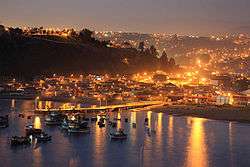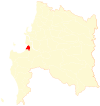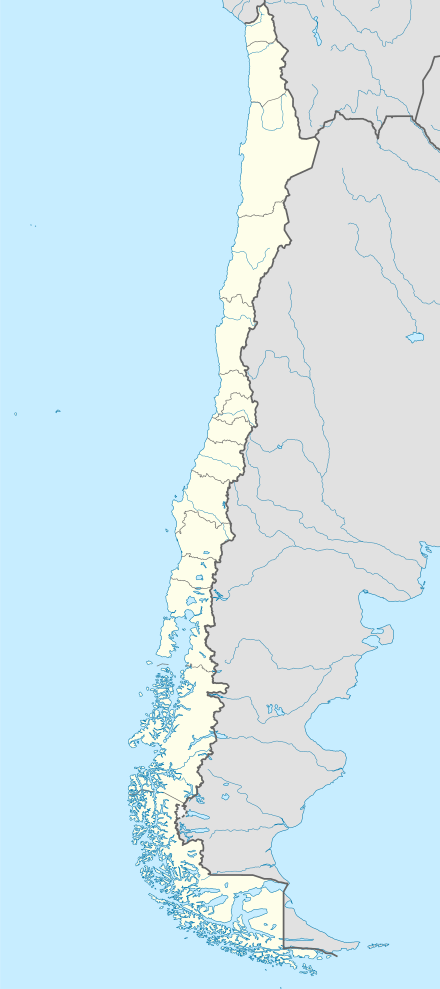Lota, Chile
| Lota | |||||
|---|---|---|---|---|---|
| City and Commune | |||||
 Dusk in Lota | |||||
| |||||
| Coordinates: 37°05′S 73°10′W / 37.083°S 73.167°WCoordinates: 37°05′S 73°10′W / 37.083°S 73.167°W | |||||
| Country | Chile | ||||
| Region | Biobío | ||||
| Province | Concepción | ||||
| Founded | 1662 | ||||
| Founded as | Santa María de Guadalupe | ||||
| Government[1][2] | |||||
| • Type | Municipality | ||||
| • Alcalde | Patricio Marchant Ulloa (PDC) | ||||
| Area[3] | |||||
| • Total | 135.8 km2 (52.4 sq mi) | ||||
| Elevation | 82 m (269 ft) | ||||
| Population (2012 Census)[3] | |||||
| • Total | 47,339 | ||||
| • Density | 350/km2 (900/sq mi) | ||||
| • Urban | 48,975 | ||||
| • Rural | 114 | ||||
| Sex[3] | |||||
| • Men | 23,944 | ||||
| • Women | 25,145 | ||||
| Time zone | UTC−4 (CLT) | ||||
| • Summer (DST) | UTC−3 (CLST) | ||||
| Area code(s) | 56 + 41 | ||||
| Website | Official website (in Spanish) | ||||
Lota is a city and commune located in the center of Chile on the Gulf of Arauco, in the southern Concepción Province of the Biobío Region, 39 kilometres south of Concepción, and is one of the ten cities (communes) that constitutes the Concepción metropolitan area. The city is mostly known for being the traditional centre of coal mining in Chile, albeit mining ended in the 1990s.
History
The first Spanish settlement, Santa Maria de Guadalupe, was founded by the governor Ángel de Peredo on October 12, 1662 but it did not survive long amidst the hostilities of the Arauco War. The modern city is linked to the coal mining industry that existed there from the mid-nineteenth century.[4] The initial trigger of coal mining was the arrival of steamships to the port of Talcahuano. These steam ships, most of whom were English, bought initially the coal very cheaply and the exploited coal seams were easy to work as they laid almost at ground level.[4] Industrialist Matías Cousiño begun mining operations in Lota in 1852.[5] Coal mining transformed rapidly Lota, from being a sparsely populated frontier zone in the mid-19th century, into a large industrial hub that attracted immigrants from all over Chile well into the 20th century.[4]
Lota was formally established as a town on January 5, 1875 and became a city on November 30, 1881. The name Lota is thought to be derived from the Mapudungun word Louta meaning small piece of land.[6]
In 1960 miners and their families started a general strike demanding higher salaries. As protesters marched on Concepción the 1960 Concepción earthquake struck the territory ending the strike.[7] During much of the 20th century the city was a stronghold of pro-Soviet communism. The city's coal mines were nationalized in 1971 by Salvador Allende, a move that was welcomed by miners. Things did however change when Allende was overthrown and the military dictatorship was established. The dictatorship outlawed Lota's political parties and powerful trade unions. People active in these organizations were persecuted, and in some instances killed by the military. Much of the local press was suppressed as it had links either to the trade unions or to political parties.[7]
As the furnaces, shipping industry and the trains all of whom were the most important buyers of coal shifted to other energy sources Lota's coal industry begun to struggle for survival in the late 20th century. This situation was not totally unforeseen as, as early as the 1920s, there were concerns for the vulnerability of the coal-dependent local economy.[7] One of the problems Lota's coal industry had to remain competitive was the difficulty to mechanize as coal beds are thin in nature and displaced by many geological faults.[8] Costs did also increased as the prizes of wood beams increased and easily accessible coal beds were depleted and mining had to be done below the sea bed.[7] The mines were closed in the 1990s after demand for Lota's coal resources diminished and cheaper Colombian coal arrived on the market, plunging the residents of Lota into poverty.[7] The endpoint came in 1997 when Empresa Nacional del Carbón closed the mines definitively and sold the industrial equipment. Subsequently, the mines were flooded.[7]
Tourism, forestry, artisan fishing and small-scale entrepreneurship has replaced mining as sources of employment, but older miners have found it difficult to adapt.[7] Despite the decline of the coal industry the Lota community continue to identify with it.[4] Compared to the 1960s and 1970s the city is very much depoliticized, evidence of this is the fact some evangelical churches have more attendants than the offices of political parties.[7]
Points of interest
- Playa Blanca
- Playa de Colcura
- Chivilingo Hydroelectric Plant
- El Chiflón del Diablo
- Parque Isidora Goyenechea de Cousiño
- Pabellón 83
Demographics
According to the 2002 census of the National Statistics Institute, Lota spans an area of 135.8 km2 (52 sq mi) and has 49,089 inhabitants (23,944 men and 25,145 women). Of these, 48,975 (99.8%) lived in urban areas and 114 (0.2%) in rural areas. The population fell by 2.3% (1167 persons) between the 1992 and 2002 censuses.[3] In the last years of the 2000s the population fell below 40,000 meaning that the population has halved since the 1980s when it was about 80,000.[7]
Administration
As a commune, Lota is a third-level administrative division of Chile administered by a municipal council, headed by an alcalde who is directly elected every four years. The 2008-2012 alcalde is Patricio Marchant Ulloa (PDC).[1][2]
Within the electoral divisions of Chile, Lota is represented in the Chamber of Deputies by Manuel Monsalve (PS) and Iván Norambuena (UDI) as part of the 46th electoral district, (together with Lota, Lebu, Arauco, Curanilahue, Los Álamos, Cañete, Contulmo and Tirúa). The commune is represented in the Senate by Victor Pérez Varela (UDI) and Mariano Ruiz -Esquide Jara (PDC) as part of the 13th senatorial constituency (Biobío-Coast).
References
- 1 2 "Asociación Chilena de Municipalidades" (in Spanish). Retrieved 23 February 2011.
- 1 2 "Municipality of Lota" (in Spanish). Retrieved 23 February 2011.
- 1 2 3 4 "National Statistics Institute" (in Spanish). Retrieved 13 December 2010.
- 1 2 3 4 Vivallos Espinoza, Carlos; Brito Peña, Alejandra (2010). "Inmigración y sectores populares en las minas de carbón de Lota y Coronel (Chile 1850-1900)" [Immigration and popular sectors in the coal mines of Lota and Coronel (Chile 1850-1900)]. Atenea (in Spanish). 501: 73–94.
- ↑ Davis, Eliodoro Martín (1990). "Breves recuerdos de algunas actividades mineras del carbón". Actas. Segundo Simposio sobre el Terciario de Chile (in Spanish). Santiago, Chile: Departamento de Geociencias, Facultad de Ciencias, Universidad de Concepción. pp. 189–203.
- ↑ "Etimología de LOTA". Etimologías de Chile (in Spanish). Retrieved January 27, 2017.
Uno pudiera pensar que la ciudad de Lota, en Chile, lleva ese nombre puesto que de ahí se extraía la mayor porción de carbón, pero no es así. Es todo lo contrario. La ciudad toma ese nombre del mapudungun louta (pequeña porción de tierra).
- 1 2 3 4 5 6 7 8 9 Reyes Herrera, Sonia E.; Rodríguez Torrent, Juan Carlos; Medina Hernández, Patricio (2014). "El sufrimiento colectivo de una ciudad minera en declinación. El caso de Lota, Chile". Horizontes Antropológicos (in Spanish). 20 (42).
- ↑ Carbón mantiene su sitial en Chile
External links
| Wikimedia Commons has media related to Lota, Chile. |
- (in Spanish) Municipality of Lota
- (in Spanish) fair of Lota



